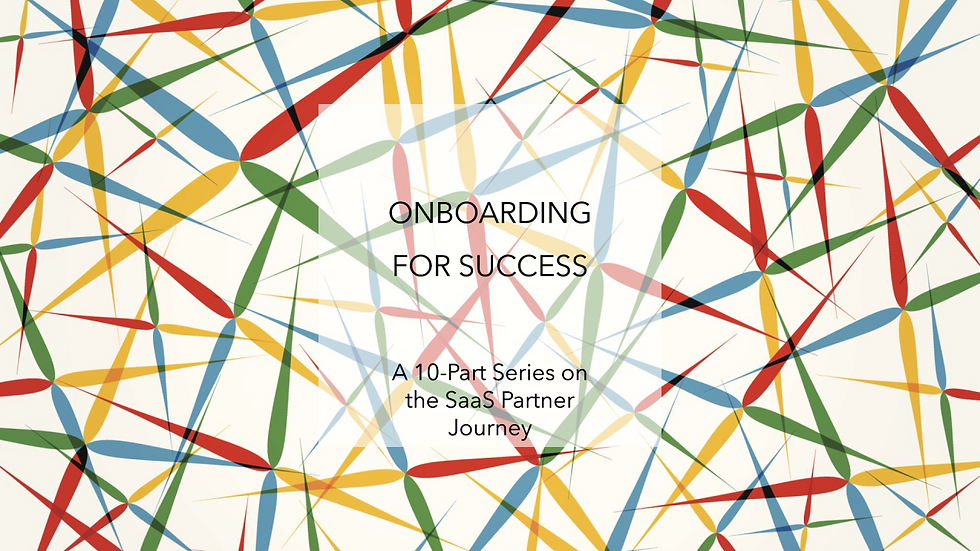Part 2 - Onboarding for Success: Accelerating SaaS Partner Programs Time-to-Value
- Matic Jezeršek
- Feb 6
- 3 min read

In the fast-moving world of SaaS, onboarding isn’t just important—it’s essential. While recruiting partners secures the relationship, onboarding determines whether that relationship delivers value. For SaaS providers, where recurring revenue depends on seamless customer experiences, onboarding represents a critical gateway to productivity and success. Yet, many organizations fall short, leaving partners underprepared to succeed in fast-paced, subscription-driven markets.
Research underscores the importance of onboarding within SaaS Partner Programs: structured programs can reduce partner ramp-up time by as much as 30-40%, improve partner retention rates by 20%, and accelerate go-to-market efforts. As Robert Hastings asserts in Channel Sales and Management (2015), “A partner’s first 90 days often dictate their long-term success.” Tony Lendrum, in Partnering to Win (2004), calls onboarding “the first handshake of trust,” framing it as a strategic opportunity to align goals and establish mutual accountability.
Why SaaS Onboarding is Critical for Partner Programs
Onboarding in the SaaS ecosystem goes beyond technical training. It is about empowering partners to deliver measurable value, build customer trust, and drive recurring revenue. Poor onboarding, by contrast, leads to churn, inefficiencies, and lost revenue.
In addition to preparing partners, onboarding is a relationship-building tool. It demonstrates your commitment to partner success and sets the tone for collaboration. This is particularly vital in SaaS, where customer lifetime value hinges on ongoing customer engagement. As Lendrum notes, “Well-onboarded partners don’t just sell—they cultivate loyalty and drive expansion.”
Crafting a World-Class SaaS Onboarding Program
Best-in-class onboarding programs deliver depth without complexity. Here are the core components of an effective framework:
1. Comprehensive Enablement
Partners need actionable knowledge about your products, markets, and customer pain points—not just slide decks. Scenario-based training helps them navigate real-world challenges.
Example: A SaaS HR platform offers interactive simulations that teach partners to address objections like ROI concerns from budget-conscious decision-makers.
2. Centralized Resource Portals
Providing partners with a single source for sales, technical, and marketing resources reduces friction and supports self-directed learning.
Example: A SaaS analytics provider creates a partner portal that includes demo videos, co-branded marketing templates, and pitch decks, ensuring consistent messaging and faster deal closures.
3. Defined Metrics and Incentives
Clarity is essential in the metrics-driven SaaS world. Partners need transparent KPIs tied to outcomes like Monthly Recurring Revenue (MRR) growth, lead conversion rates, or customer satisfaction scores.
Example: A CRM SaaS firm sets specific quarterly revenue benchmarks and offers bonuses for hitting upsell and cross-sell targets.
4. Dedicated Support Teams
Assigning onboarding specialists ensures partners receive tailored guidance during the critical early phase. This hands-on support builds confidence and loyalty.
Example: A cloud computing company assigns a partner success manager to each new partner, ensuring a personalized onboarding experience.
Scaling SaaS Onboarding with Efficiency
For SaaS providers managing diverse, global partner ecosystems, scalability is critical. Leading companies streamline their onboarding efforts through:
1. Automated Learning Platforms
SaaS-focused Partner Relationship Management (PRM) systems automate training, resource sharing, and progress tracking.
Example: A project management SaaS firm uses PRM software to reduce onboarding time by 30%, enabling partners to go to market faster.
2. Segmented Enablement Paths
Not all partners have the same expertise. Tailored tracks ensure each partner type gets the support they need.
Example: A cybersecurity SaaS firm creates separate tracks for managed service providers and resellers, allowing each to maximize their value.
3. Continuous Feedback Loops
Onboarding is iterative. Regular surveys and feedback sessions allow organizations to identify and resolve pain points in real-time.
Example: A collaboration SaaS provider holds monthly feedback calls with partners, using insights to refine training and resources.
Avoiding Common SaaS Onboarding Pitfalls
Even the most sophisticated programs can falter. Watch out for these common issues:
Overwhelming Partners: Phased training schedules prevent information overload and ensure gradual learning.
Resource Gaps: Smaller partners may struggle to allocate time. Offering flexible schedules or completion incentives can mitigate this.
Regional Inconsistencies: Global partners often need localized training and resources to account for market differences.
Why SaaS Onboarding Matters Now More Than Ever
In SaaS, time-to-value is everything—for both partners and customers. Effective onboarding empowers partners to accelerate sales cycles, deliver measurable results, and deepen customer relationships. Research shows that companies investing in onboarding see 50% faster partner productivity and greater alignment across their ecosystems.
As Hastings aptly states, “A well-onboarded partner is not only productive but also loyal.” For SaaS providers, this loyalty translates into more predictable revenue streams, higher customer retention rates, and a stronger competitive edge.
A Call to Action
What steps can your SaaS business take to improve partner onboarding? Whether it’s automating training modules, tailoring enablement paths, or creating continuous feedback loops, the time to act is now. A faster, more efficient onboarding process not only accelerates growth but also ensures long-term partner success.
References
Hastings, Robert. (2015). Channel Sales and Management. AMACOM.
Lendrum, Tony. (2004). Partnering to Win: The Art of Business Alliances. Wiley.

Commenti